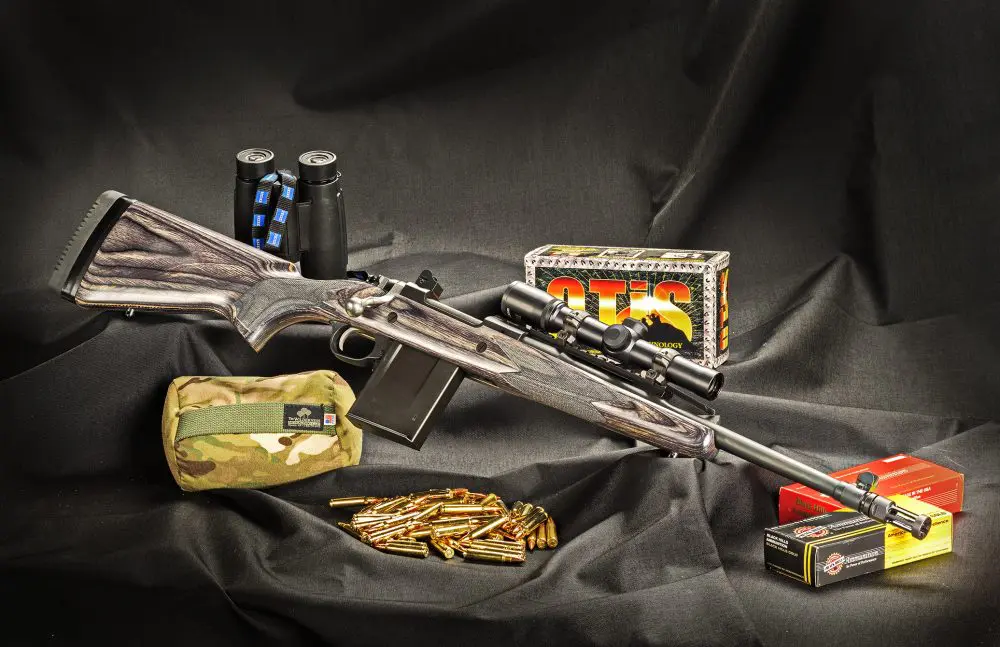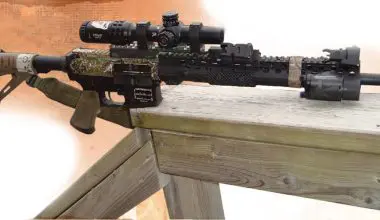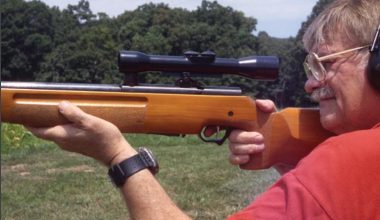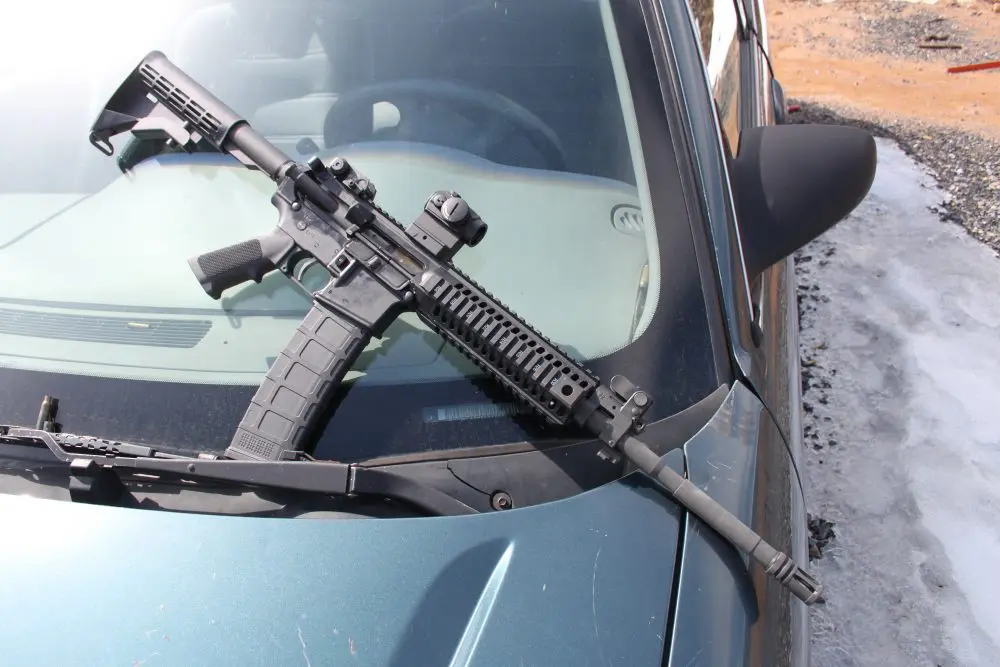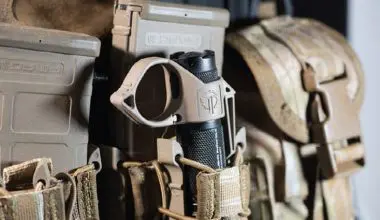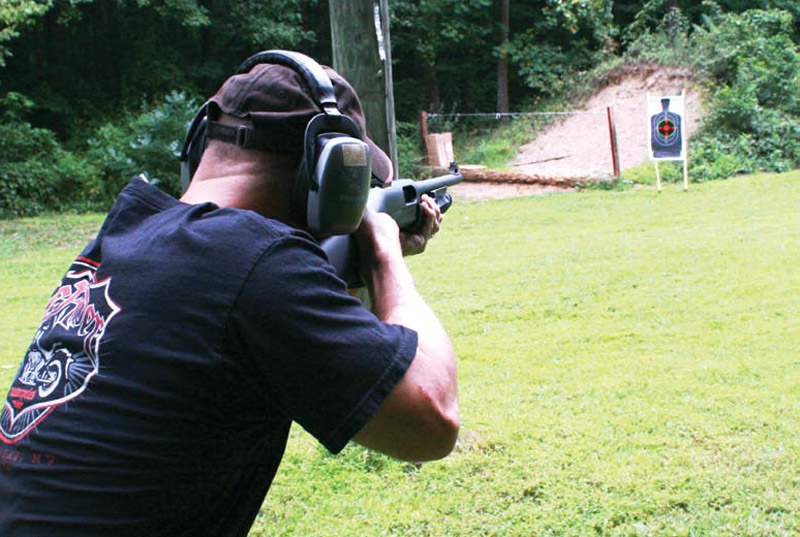
Duplex and multiplex loads have been employed in combat since the days of muzzleloaders, especially in light field and naval artillery pieces.
Loads usually consisted of a combination of large (primary) and small (secondary) projectiles. Often they were employed against massed charging infantry and ship’s rigging. Duplex and multiplex can also mean a combination of propellants such as black and smokeless powders. With multiple and irregular projectiles, the goal was, and still is, improved hit ratios.
In some special applications, duplex loads have been used for the penetration of highly resistant glass for hostage rescue. The first round would create the opening and the second, immediately following, would strike the target through the initial hole. When training with Germany’s GSG 9 at their Hangelar- St. Augustin headquarters, I fired a Heckler & Koch two-shot burst rifle chambered in 5.56x45mm.
It was in sporting rifle configuration with wood furniture and had an extremely high cyclic rate of fire. It was specifically designed for barrier penetration, but its recoil, although very light, was sufficient enough that the warp-speed double tap was never able to vector in on the initial penetration and consistently produced a close but distinct two-shot group. It was eventually abandoned.
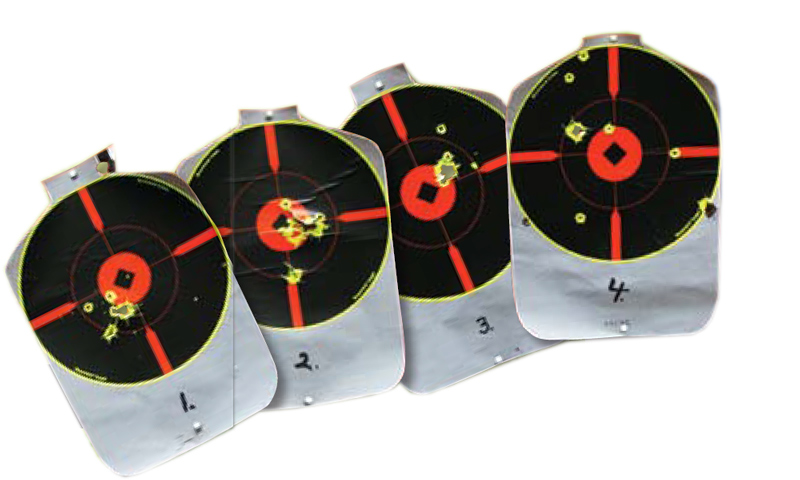
Table of Contents
GEORGE WASHINGTON’S FAVORITE
Early in our martial history, “Buck-n- Ball” was a close-range favorite of General George Washington. The idea was to combine the range and penetration of the ball or slug with the up-close lethality of the smaller pellets and increase hit probability.
During the Civil War, a .65-caliber ball was frequently preceded by three buck shot balls contained in a blackpowder paper cartridge. The larger lead sphere acted like a gas seal in the smooth-bore barrel.
WINCHESTER PDX1
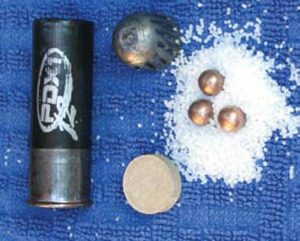
Except for specialty ammunition loading entities, the Buck-n-Ball shotgun load has lain mostly dormant until recently. Winchester is now fielding its 2 ¾-inch PDX1 12-gauge shell with oneounce rifled slug (.73 caliber) capped with three copper-plated 00 (.33 caliber) buck pellets.
The load is buffered with GREX to reduce the effects of accuracy-reducing pellet collision. At close-quarters shotgun ranges, the lighter pellets will strike the target first, but at ranges beyond 50 yards, the slug, with its better weightretaining velocity, may pass through the pattern and wallop the threat slightly before the pellets arrive on scene. Typically, the hollow base slug is weighted in the nose and has grooves engraved in its hull to give it some spin for enhanced accuracy. The black-oxide hulled, highbase, star-crimped shells come ten to a box.
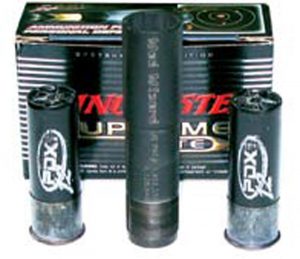
FIELD TESTS
Recoil is typical of 12-gauge slug loads, but not punishing if you mount the gun properly. Although they are reduced recoil shells, they still punch and exited my Fit 4 Duty modified Mossberg 500’s 18.5-inch barrel with perceived authority.
Muzzle blast was prominent and, with a virtual shower of GREX buffering, my chronograph’s screens were shaken enough to prevent me from getting consistent readings. Winchester Project Manager Brad Criener telephonically advised that they clock the PDX1 at 1,150 feet-per-second from a 30-inch cylinder bore test barrel and to deduct approximately 150 fps from the 500’s shorter tube. Winchester intentionally lowered the velocity of the heavier 1 3/8-ounce payload to create a balance between recoil and penetration.
The PDX1 is a bridge load between pure slug and buckshot loads, and the engineers wanted to avoid the excessive penetration that is often a characteristic of slugs. Criener advised that in ballistic gelatin, the slug penetrated 24 to 27 inches and the buckshot 17 to 20 inches on average.
Flash and smoke were virtually nonexistent, and the target remained in view at all times even in 90 degree, high-humidity weather.
Targets were engaged at close and extended ranges. Walker’s Wad Wizard barrel choke produced tight but not buckshot-type “rat hole” groups at close ranges. While still condensed out to 15 yards, patterns noticeably opened up at 25 yards, but payloads remained in the chest cavity area.
Fifty-yard targets were not safe, as the results were so inconsistent that hits could not be guaranteed on individual targets. There were more hits than misses, but they ranged from the neck to the chest and legs with the same hold on the target. Collateral damage could therefore be expected. Criener noted that at 40 yards, the slug printed generally three inches low at center and the buckshot was unpredictable.
MOSSBERG REALIZED GROUPS
With a chest hold, a three-inch group was punched into paper at seven yards. Groups increased an inch at ten yards, but at 45 feet, the lead cluster retreated back down to three inches. Go figure. I fired two center-mass shots at 25 yards and got two thoracic groups that ranged from 4 1/2 to 10 1/2 inches.
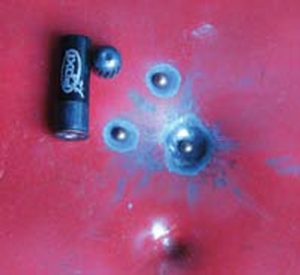
BENELLI’S TURN
Not satisfied, I repeated the range tests with Benelli’s cylinder bore Nova Tactical 12 gauge to determine if the specialized choke on the Mossberg skewed results. With this well-designed smoothbore and the PDX1 load, it printed a 3.75-inch group on the Birchwood Casey 21-foot target with the slug centered and the wad looking even more destructive at 11 o’clock.
At ten yards, all projectiles remained in the chest cavity with a slug centered 6.75-inch pattern. The 15-yard paper threat was destroyed, with all elements of the payload residing in the eight ring. Both the slug and wad tore up the ten ring. The 25-yard silhouette target received two central and two peripheral “wounds” with a 14.5-inch center hold group. The slug registered at one o’clock in the ten ring.
HARD TARGET PENETRATION
To determine penetration potential, I slammed a PDX1 round into a coldrolled sheet of 14-gage steel at ten yards. Eighteen- to 20-gage steel is commonly used in car bodies. Fourteen-gage steel is found in cross members and frame rails. While the steel was not compromised, the slug with a pellet in tandem almost got through and left a substantial crater in the metal. A highly distorted slug, red hot to the touch, lay at the sheet’s base. While the two other pellets merely dimpled the sheet, I have no doubt that the slug will penetrate a vehicle’s lighter fuselage and windscreen.
CONCLUSIONS
Like the old timers, Winchester wanted to create a round that possessed some of the attributes of high hit ratio buckshot and combine it with the longer range accuracy of the slug while keeping felt recoil of the heavier payload tolerable by reducing velocity. They have successfully accomplished this in a manner typical of this innovative company, which is perpetually improving “the breed.”
When the situation suddenly shifts and more range and penetration are called for, the PDX1 will provide that instant versatility without switching ammunition.
However, if you require denser multiple wound-creating patterns with reduced penetration at typical gun-battle ranges, stick with the 9- and 12-pellet 00 loads. For more accuracy, greater range and increased penetration slugs are the ticket.
The PDX1 is an attempt to combine the best of both worlds, and Winchester has certainly achieved that.
